Free Copyright Images of Black People Dressed Inn White
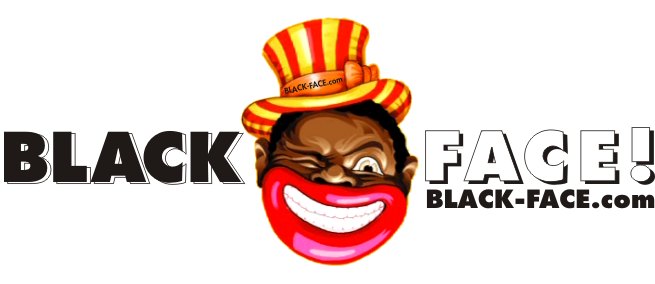 |
Blackface!The mask which the actor wears is apt to become his face -- Plato Blackface is more than just burnt cork applied as makeup. It is a style of entertainment based on racist Black stereotypes that began in minstrel shows and continues today. |
|
Racist Black StereotypesOriginating in the White man's characterizations of plantation slaves and free blacks during the era of minstrel shows (1830-1890), the caricatures took such a firm hold on the American imagination that audiences expected any person with dark skin, no matter what their background, to conform to one or more of the stereotypes: | |
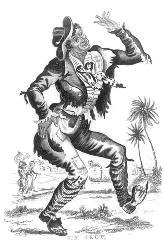 | 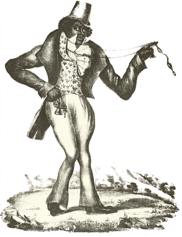 |
| Jim Crow The term Jim Crow originated in 1830 when a White minstrel show performer, Thomas "Daddy" Rice, blackened his face with burnt cork and danced a jig while singing the lyrics to the song, | Zip Coon First performed by George Dixon in 1834, Zip Coon made a mockery of free blacks. An arrogant, ostentatious figure, he dressed in high style and spoke in a series of *malaprops and puns that undermined his attempts to appear dignified. *the mistaken use of an incorrect word in place of a word with a similar sound |
Jim Crow and Zip Coon eventually merged into a single stereotype called simply "coon." | |
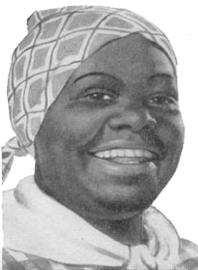 | 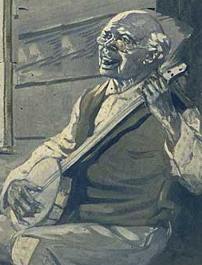 |
| Mammy Mammy is a source of earthy wisdom who is fiercely independent and brooks no backtalk. Although her image changed a little over the years, she was always a favorite of advertisers. | Uncle Tom Toms are typically good, gentle, religious and sober. Images of Uncle Toms were another favorite of advertisers. |
| PepsiCo (Aunt Jemima syrup and pancake mix) and Mars (Uncle Ben's Rice) finally announced in 2020, that they were removing the characters that began as minstrel show stereotypes from their packaging and brands. | |
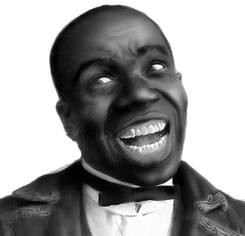 | 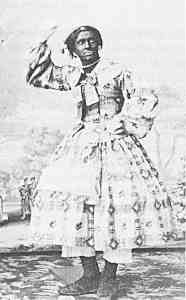 |
| Buck The Buck is a large Black man who is proud, sometimes menacing, and always interested in White women. | Wench/Jezebel The temptress. During the minstrel era, wenches were typically a male in female garb. In film, wenches were usually female mulattos. |
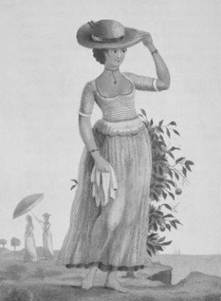 | 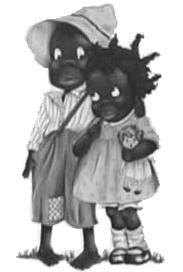 |
| Mulatto A mixed-blood male or female. In film, often portrayed as a tragic figure who either intentionally or unintentionally passes for White until they discover they have Negro blood or are discovered by another character to be Black. | Pickaninny Picaninnies have bulging eyes, unkempt hair, red lips and wide mouths into which they stuff huge slices of watermelon. |
These stereotypes were staples during the minstrel era and carried over into vaudeville, film and television.
Blackface in Minstrel Shows
Blackface makeup was either a layer of burnt cork on a layer of coca butter or black grease paint. In the early years exaggerated red lips were painted around their mouths, like those of today's circus clowns. In later years the lips were usually painted white or unpainted. Costumes were usually gaudy combinations of formal wear; swallowtail coats, striped trousers, and top hats.
Minstrel show entertainment included imitating black music and dance and speaking in a "plantation" dialect. The shows featured a variety of jokes, songs, dances and skits that were based on the ugliest stereotypes of African American slaves. From 1840 to 1890, minstrel shows were the most popular form of entertainment in America.
White audiences in the 19th Century wouldn't accept real black entertainers on stage unless they performed in blackface makeup. One of the first Blacks to perform in blackface for White audiences was the man who invented tap dancing, William Henry Lane, aka Master Juba. Lane's talent and skill were extraordinary and eventually he became famous enough that he was able to perform in his own skin.
In the late 1800s one of the most popular of the blackface performances was the adaptation of Uncle Tom's Cabin; an antislavery tale, it met with few objections even from anti-theater religious leaders. A mixture of minstrel show, circus, and spectacle; with trained dogs, ponies, and sometimes even a crocodile, it remained the most popular play in America for over a century.
The American minstrel show was effectively dead by WW1, yet some old-timers continued to peddle the same blackface stereotypes later in vaudeville, films and television. It's one of the interesting twists of history that in the first half of the twentieth century, the main purveyors of the old-fashioned blackface minstrel tradition were Black performers, who'd began in show business wearing the blackface mask -- either literally or figuratively -- and were reluctant to give it up.
But they also had little choice in the roles they were offered. Until well into the 1950s, Black male actors were limited to stereotypical roles: Coons, for example, Stepin Fetchit, Mantan Moreland, and Willie Best; and Toms, the most famous were Bill "Bojangles" Robinson and Eddie "Rochester" Anderson. Likewise, the only film roles for Black women were maids and mammys, and the most famous mammy of all was Hattie McDaniel, best known for her Oscar-winning role as "Mammy" in Gone With the Wind.
Vaudeville
Vaudeville was popular in the United States from the 1880s until the early 1930s. It offered a more family-friendly atmosphere than the variety shows that had come before, which catered mostly to rowdy working-class audiences.
Vaudeville began at Tony Pastor's Opera House in New York's Bowery. By 1900, it had become a nationwide network of hundreds of theaters and was the dominant form of American mass entertainment. Each show was a variety of separate, unrelated acts -- short plays, musicians, acrobats, animal acts, dancers, magicians, and comedy routines -- grouped together on a common bill. For a time, vaudeville was the most popular form of live theater but it died out with the advent of talking pictures. Many of the 20th Century's most famous performers got their start in Vaudeville including Eddie Cantor, Al Jolson, Charlie Chaplin, The Marx Brothers, WC Fields, Jack Benny, and Bob Hope.
The heritage of blackface minstrelsy played a major part in the evolution of the song, dance, comedy acts and routines that vaudeville popularized, but actual performances in blackface were mostly relegated to a single skit or a song. However blackface in vaudeville also provided opportunities for Blacks who performed in blackface. The success of Black comedians such as Ernest Hogan, Bert Williams, and George Walker opened the door for multiracial casts and for later black performers to take the stage without blackface.
Blackface on Broadway
The most popular Black stage performer of the early 1900s was a brilliant comedian named Bert Williams, who performed a coon stereotype in blackface he called the Jonah Man. Williams teamed up with George W. Walker, and billing themselves as "Two Real Coons" they soon became one of the most successful comedy duos, while their act went from vaudeville to Broadway and evolved into full-scale musical comedy. They produced, wrote and starred in In Dahomey (1902), the first Black musical comedy to open on Broadway. After his partner died, Williams became the first Black to headline a Ziegfield Follies show and the first Black comedian to produce and star in his own silent films.
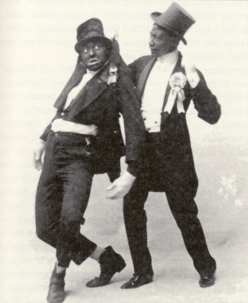
Bert Williams and George Walker
Silent Movies
The popularity of early film brought with it the propagation of racial stereotypes to large audiences around the world. Early silent movies such as The Wooing and Wedding of a Coon in 1904, The Slave in 1905, The Sambo Series 1909-1911 and The Nigger in 1915 offered the existing stereotypes through an exciting new medium.
The premiere of Birth of a Nation in 1915 marked a change in emphasis from the pretentious and inept Jim Crow stereotypes to that of the Savage Negro. In D.W. Griffith's film, the Ku Klux Klan rescues the South, and Southern women in particular, from savage Blacks who have gained power over Whites with the help of Northern carpetbaggers. Griffith later admitted that his film was designed to, "create a feeling of abhorrence in white people, especially white women, against colored men."
Race Movies
Northern Blacks responded to Birth of a Nation by producing their own movies. "Race movies" were all-black affairs that were made for Black audiences. The most successful Black film producer of the first half of the Twentieth Century was a former railway porter and novelist named Oscar Micheaux. His Chicago-based Micheaux Film Corporation, which operated from 1918–1940 produced over 44 films. Micheaux's most important film was Within Our Gates (1920), an uncompromising look at racial attitudes and prejudice among both Blacks and Whites, and it included both a rape and a lynching.
The growth of truly independent Black film production was cut short by the Great Depression and the added costs associated with the change in technology from silent to sound. Few of the small independent Black film companies survived the changes and even fewer remained independent once Hollywood stepped in and took control of Black filmmaking by providing the financing. Race movies then changed from organic Black entertainment to knock-offs of standard Hollywood fare; like westerns, crime dramas and musicals; but featuring an all-Black cast.
Racist Cartoons
Between 1930 and 1950, animators at Warner Brothers, Walt Disney, MGM, Merrie Melodies, Looney Tunes, R.K.O., and many other independent studios, produced thousands of cartoons that perpetuated the same old racist stereotypes. This period is now known as the golden age of animation, and until the mid 1960s, cartoons were screened before all feature films. Later, these same cartoons would cycle endlessly for decades on broadcast TV or cable syndication.
Eventually the worst of the racist cartoons were removed from television or heavily edited, but many are available on the internet if one knows where to look. To modern audiences, many of these cartoons are quite shocking and graphically illustrate how pervasive and institutionalized racism was in our culture just a short time ago.
Radio
The most popular radio show of all time was The Amos 'n' Andy Show. The characters were created by Freeman Gosden and Charles Correll; two white actors with blackface and vaudeville experience. NBC began broadcasting Amos 'n' Andy on radio August 19th, 1929 and it was an instant success. It was the first radio program to be distributed by syndication in the United States. The show ran as a nightly radio serial from 1928 until 1943 and as a weekly situation comedy from 1943 until 1955. Portraying blackface racist stereotypes on radio was a bit of a challenge because there were no visuals. The stereotypical voice characterizations needed to be even more exaggerated to help listeners distinguish between characters.
Although Amos and Andy is cited most often as an example of blackface radio performances, there were many other stereotypical blackface characters in old time radio shows like Two Black Crows, Beulah and Aunt Jemima. Two Black Crows were based on coon stereotypes while both Beulah and Aunt Jemima were based on the "Mammy" stereotype. Beulah was a supporting character on the popular Fibber McGee and Molly radio series and became a spin-off show. The show was broadcast on radio from 1945 to 1954, and originally portrayed by White actor Marlin Hurt. Hattie McDaniel eventually took the role on radio and was one of four black women to play Beulah on the later television series.
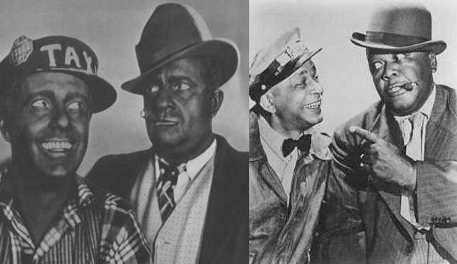
Amos 'n' Andy on radio and TV
Early Television and the Civil Rights Movement
When integration became Federal law in the 1950s it put small Black theaters out of business and that brought an end to the production of race movies. Blacks continued to play servant roles in mainstream movies but the only Blacks to appear in early television were those who performed racist caricatures. Much of early television's variety entertainment was transplanted from vaudeville, while many situation comedies came from radio. Popular radio shows like Amos and Andy and Beulah were an instant success on television. But it wasn't long before a backlash developed from Black leaders who objected to the racist stereotypes and especially the fact that they were the only portrayals of blacks on TV.
Even as the TV series Amos 'n' Andy premiered in June 1951, the NAACP was in federal court trying unsuccessfully to get an injunction to prevent CBS from televising it. In 1951, Amos 'n' Andy ranked 13th in the Nielsen ratings and in 1952 it won an Emmy award. The NAACP responded by initiating a boycott of its sponsor, Blatz beer. By April 1953 Blatz withdrew its sponsorship and CBS announced "The network has bowed to the change in national thinking." Yet the series was in syndication more than 4 times as long as it was broadcast on the network. It remained in syndication for 13 years after it was withdrawn from the network schedule. As late as 1963, it still played on 50 US stations. The programs were finally locked in vaults as of 1966, but videotapes and DVDs continue to circulate among collectors.
NAACP protests also resulted in blackface scenes being cut from TV showings of such films as Babes in Arms and Holiday Inn. 15 years passed from Amos 'n' Andy until the introduction of another Black situation comedy (Julia in 1968). The series failed to gain an audience and that may explain why during the 1970's, stereotypical "coons and mammies" were again featured in shows such as Sanford and Son, The Jeffersons, Good Times, What's Happening and Diff'rent Strokes.
Blaxploitation (Blacksploitation) Films
The 1970s also saw a resurgence of movies tailored to Black audiences in a genre called "Blacksploitation" films. Sweet Sweetback's Baadasssss Song (1971) starred Melvin Van Peebles, who also wrote, produced and directed. In the film, his character is a black prostitute who is forced to go on the run after he saves a young Black Panther who was being beaten by two corrupt White cops. The film is often credited with the invention of the Blacksploitation genre, because its success proved that there was a lucrative market for such films. The film cost only $150,000 -- most of it put up by Peebles -- and grossed over $15 million. Superfly, Shaft, Blackula, Black Caesar, Hell up in Harlem, Black Gestapo, Foxy Brown, and many others quickly followed.
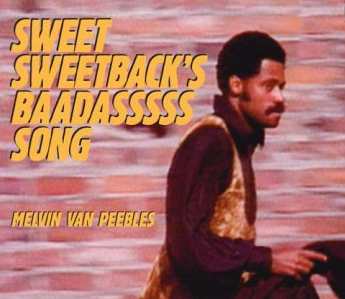
Melvin Van Peebles
Most Blacksploitation films were small, independent productions that dealt with crime and the effects of illegal drugs on the inner cities. The cause was usually portrayed as being a result of White racism and exploitation of poor Blacks. Most White cops and politicians were portrayed as corrupt, forcing Black antiheroes to take matters into their own hands. Heavy on graphic sex scenes, gratuitous nudity and violence, as well as stereotypes of pimps, whores, and black criminals, the films eventually generated a backlash led by Black leaders that put an end to Blacksploitation films by 1980.
An Enduring Legacy
In Bamboozled (2000), Spike Lee addresses the legacy of blackface minstrelsy, and raises the question of who is wearing the blackface now. Many of the Black characters in television comedies today are derived from the same racist stereotypes of blacks that have existed since the days of minstrel shows. The FOX Television sitcom, South Central (1994) was, in the words of Brotherhood Crusade President Danny Blackwell, "the Amos 'n' Andy of 1994." The Parent 'Hood (1995-2000), a program aimed at family viewers, relied on working class coon and mammy caricatures for a good portion of its humor.
In Homeboys in Outer Space (1996), Flex Alexander and Darryl M. Bell, "mercenary brothaa-aas, down for one anothaa-aaa" explore black stereotypes and the galaxy in their Space Hoopty; a lowrider-style spacecraft equipped with a computer named Loquatia spouting "ghetto sass." More recently, Fox Television's Method & Red (2004) transplanted hip hop recording artists Method Man & Redman to a White upper-class suburb in New Jersey, where they began "Puttin' the Urban into Suburban" to the horror of their White neighbors. The Cleveland Show (2009-2013) is basically Family Guy in blackface with a liberal helping of negative Black stereotypes. 180 years after "Daddy" Rice donned blackface makeup and sang Jump Jim Crow for white audiences, Black television comedies today are still relying on the same old coon and mammy stereotypes for cheap laughs.
Blackface montage from Spike Lee's Bamboozled (2000)
Tyler Perry, currently the most prolific Black producer, director, actor, writer, and one-man multimedia conglomerate has populated many of his stories with classic stereotypes. Perry's recurring mammy character, Mabel "Madea" Simmons appears in much of his work and is played in drag by Perry himself. Perry first introduced Madea in his 1999 play I Can Do Bad All By Myself and the character has appeared in many of his subsequent films. Perry has said he based Madea on an aunt who lives in Georgia, as well as on his mother and several other women he knew from his childhood.
In 2009, director Spike Lee criticized Perry's work, saying, "Each artist should be allowed to pursue their artistic endeavors but I still think there is a lot of stuff out today that is 'coonery' and buffoonery...As African Americans, we're not one monolithic group so there is room for all of that, but at the same time, for me, the imaging is troubling and it harkens back to Amos 'n' Andy." Perry has bristled at the criticism but he also has gone on to much more serious work, producing with Oprah Winfrey the critically acclaimed, Push: Based on the Novel by Sapphire, an uncompromising look at one Black girl's journey from sexual, physical and mental abuse, and teen pregnancy to adulthood and independence.
Blackish, (2014-) is a sitcom about a father of four who worries that his four children aren't "black enough" -- they are losing touch with urban, black culture because of their affluent upbringing. The show confronts notions of blackness as well as certain behaviors that are considered "black" and the fact that many black people feel the need to embody those attributes because if they don't, they won't be considered authentically black. What makes Blackish unique is its strong writing and irreverent look at the issues facing an upper class black family. This broad, warm-hearted comedy confronts issues of race, class and culture every week as the father, played by Anthony Anderson, tries to toughen the kids up, because he thinks that if they don't get "blacker" he will have failed as a father.
Blackface in Music Videos
Negative stereotypes of Blacks are a staple of Black music videos that glorify gangsterism. The "buck" is now a hoodlum with an attitude and the minstrel-show plantation has morphed into a music video version of gangster life. Though the setting has changed from an idyllic plantation to the mean streets of urban America, the process remains the same; a black culture is being marketed for profit, with black performers portraying negative stereotypes. Performers believe they are representing authentic black America, while critics decry the glorification of ugly caricatures and how it influences the attitudes and perceptions of Black youth.
In May 2018, Donald Glover, aka Childish Gambino turned the Jim Crow stereotype on its head with his music video This Is America -- confronting black minstrel stereotypes in the media, gangster rap, gun violence and police brutality. Gambino reminds us of the 2015 Charleston mass shooting, the Black Lives Matter movement, and America's tolerance of gun violence while dancing and striking poses that are reminiscent of Jim Crow. The video ends with Gambino running as fast as he can through a dark hall while being chased by white shadows. But no matter how fast he runs, they are still closing in on him. Gambino wants us to understand that for American blacks, racism and white supremacy are inescapable.
Digital Blackface
Because of the relative anonymity of online interactions, an increasing number of non-Black people have been masquerading as Blacks while using Black vernacular and portraying stereotypes from the minstrel era. Other examples of digital blackface include the proliferation of White people posting memes featuring news station videos of blacks that have been turned into caricatures.
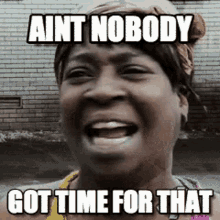
At first glance, digital blackface may not seem that bad, but it is just another example in the long history of dehumanizing stereotypes that have been portrayed using each new entertainment media since the 1830s. It may be some time yet before we as a society evolve beyond this behavior, if ever, but as individuals we can be aware that there are real-world consequences to negative stereotypes and not perpetuate them.
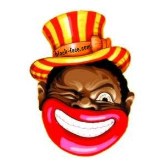
History of Minstrel Shows |
Blacks in Blackface - |
Free Copyright Images of Black People Dressed Inn White
Source: https://www.black-face.com/


0 Response to "Free Copyright Images of Black People Dressed Inn White"
Post a Comment